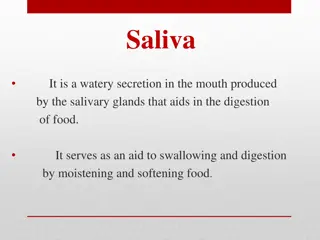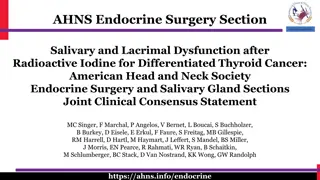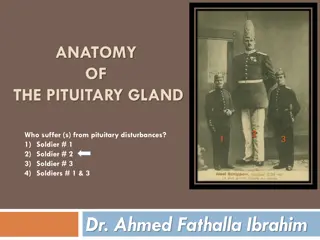SALIVARY GLAND IMAGING
Salivary gland imaging plays a crucial role in diagnosing and monitoring diseases of the major salivary glands, including the parotid, submandibular, and sublingual glands. Different imaging techniques such as computed tomography, MRI, and ultrasound are used to visualize these glands and aid in differentiating normal from abnormal findings. Conventional radiography and sialography are also valuable tools in evaluating salivary gland health. This overview provides insights into the anatomy, imaging modalities, and diagnostic capabilities related to salivary gland imaging.
Download Presentation

Please find below an Image/Link to download the presentation.
The content on the website is provided AS IS for your information and personal use only. It may not be sold, licensed, or shared on other websites without obtaining consent from the author.If you encounter any issues during the download, it is possible that the publisher has removed the file from their server.
You are allowed to download the files provided on this website for personal or commercial use, subject to the condition that they are used lawfully. All files are the property of their respective owners.
The content on the website is provided AS IS for your information and personal use only. It may not be sold, licensed, or shared on other websites without obtaining consent from the author.
E N D
Presentation Transcript
The parotid, submandibular and sublingual glands are regarded as major salivary glands and have bilaterally symmetric lobes. The parotid gland (the largest salivary gland) is situated at the parotid space. ANATOMY AND OUTLINE OF IMAGING The gland is divided into deep and superficial lobes by branches of the facial nerve. The duct of salivary secretion is known as Stensenduct that runs anteriorly on the superficial portion of the masseter muscle and pierces the buccinatormuscle.
The submandibular gland is located mainly in the so-called mandibular triang. The secretory duct is known as Wharton duct that runs on the surface of the mylohyoidmuscle and opens at the anterior portion of the floor of the mouth. ANATOMY AND OUTLINE OF IMAGING The sublingual gland is located under the mucosal surface of the oral cavity and lies on the mylohyoidmuscle. The gland has many small ducts known as ductsBartholin that open directly on the mucosal surface of the floor of the mouth. Some of these small ducts are fused with Wharton duct.
Conventional imaging: This includes occlusal, panoramic or posteroanterior(PA) views. Sialography: It is defined as a method of radiographic study of the salivary gland and alveoli of the parotid and submandibular salivary glands. Types of Salivary Gland Imaging Computed tomography: It demonstrates small differences in soft-tissue radiographic examination and distinction between gland and the adjacent soft tissues is greatly improved. MRI: It is useful in discrete swelling of salivary glands and provides excellent soft-tissue details. It readily enables differentiation between the normal and the abnormal. USG: It involves the transmission of energy into the salivary tissues, receiving of the energy after the tissues have reflected it and recording it so that it can be presented for interpretation.
CONVENTIONAL RADIOGRAPHY Mainly views taken in CR are occlusal, panoramic, and lateral oblique view and PA views. It is generally limited to detection of sialoliths, primarily in submandibular gland, Stensenduct and Wharton duct. Sialolithsoccur more frequently in submandibular gland than in parotid gland. They can rarely be seen in sublingual or minor salivary gland. On conventional extraoralradiography, such as panoramic tomography and PA radiography, a sialolithof the submandibular gland usually appears as a round, isolated radio-opaque mass beneath the inferior border of the mandible.
SIALOGRAPHY Sialographyis a radiographic procedure for detection and monitoring salivary gland disease. It is used to examine the ductal acinarsystem of major salivary gland by injecting radio-opaque contrast medium into the gland to make it visible on radiographs. After injection of contrast agent radiographs are taken on plane film. The lateral oblique is best to delineate submandibular gland because it projects image below the ramus of jaw. Occlusal view is taken for sialolithslocated in anterior portion of duct. For parotid gland, anteroposterior(AP) and panoramic view can be taken. After sialographicview is taken the catheter should be removed from duct orifice. Patient is instructed to chew gum or suck on lemon .
COMPUTED TOMOGRAPHY It is valuable in examining salivary gland, particularly after injection of contrast media, i.e. CT sialography. CT enables the lesions and changes in surrounding structures to be visualized. CT View of Normal Salivary Gland Parotid gland: It has increased fat content and is encased in a dense capsule. Because of this, parotid gland on CT is consistently more radiolucent than surrounding muscle and is distinctly more radioopaquethan adjacent fat. Parotid duct is not routinely seen on CT without contrast opacification.
Submandibular gland is more radiopaque than parotid gland but of Submandibular gland the same density as that of adjacent muscle. Sublingual gland: This appears as relatively lucent fatty structures.
MRI, like CT, has several advantages over CR for disease localisation. The difference between MRI and CT is in tissue differentiation. MAGNETIC RESONANCE IMAGING Because MRI is superior to CT for the tissue differentiation, it is more effective for qualitative diagnosis, such as determining whether a tumouris benign or malignant.
ULTRASONOGRAPHY USG is based on inaudible sound in the range of frequency approximately 20,000 to 10 billion (109) cycles/s. It has different velocities in tissues that differ in density and elasticity from others. Normal Appearance of Parotid Gland :parotid gland appears as a homogeneous hyperechoicarea. Submandibular Gland: The normal submandibular gland also appears as a homogeneous hyperechoicarea relative to the surrounding muscles, such as the mylohyoidand digastric muscle.
Doppler Sonography Doppler Sonography Intraglandular blood flow can be demonstrated with Doppler sonography.
Thank You Thank You























